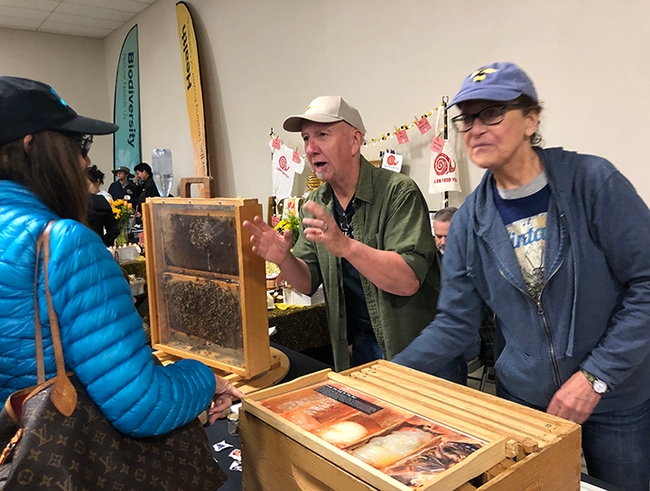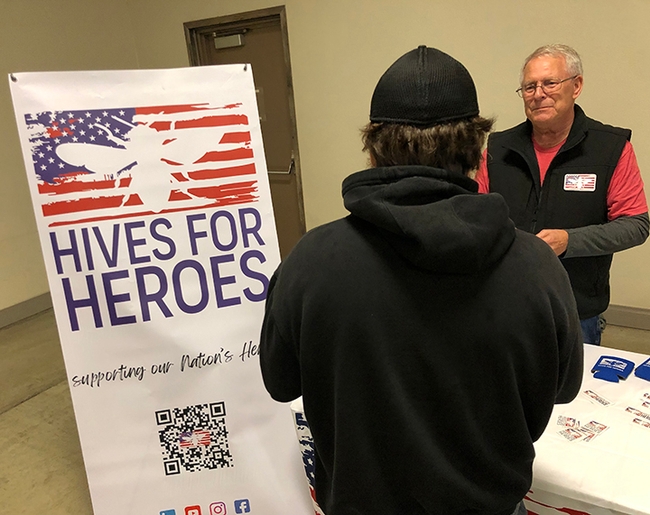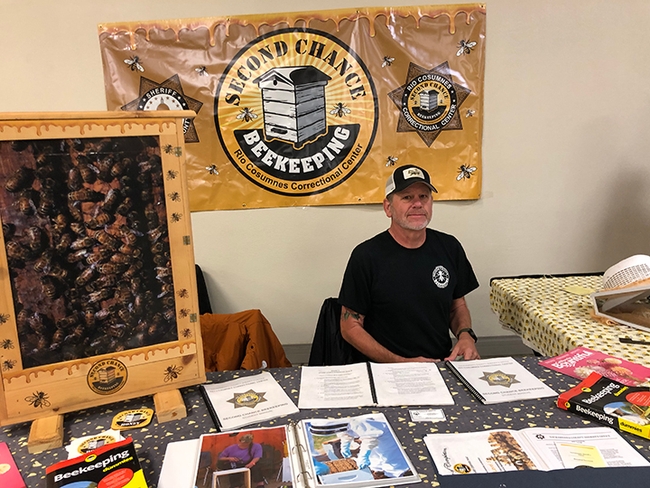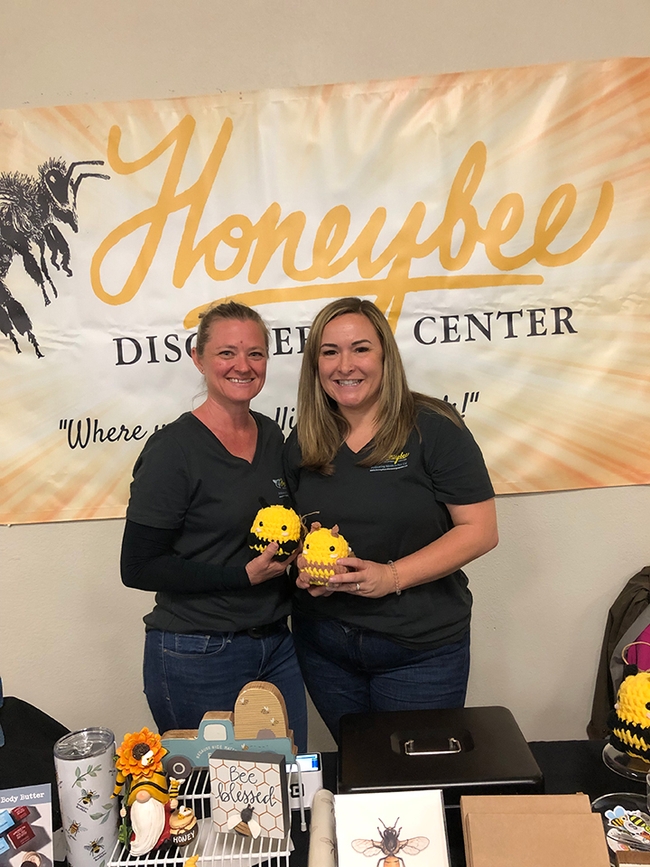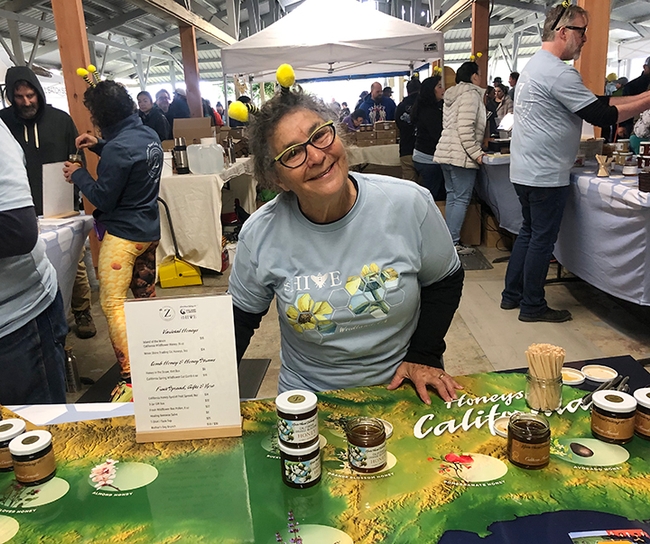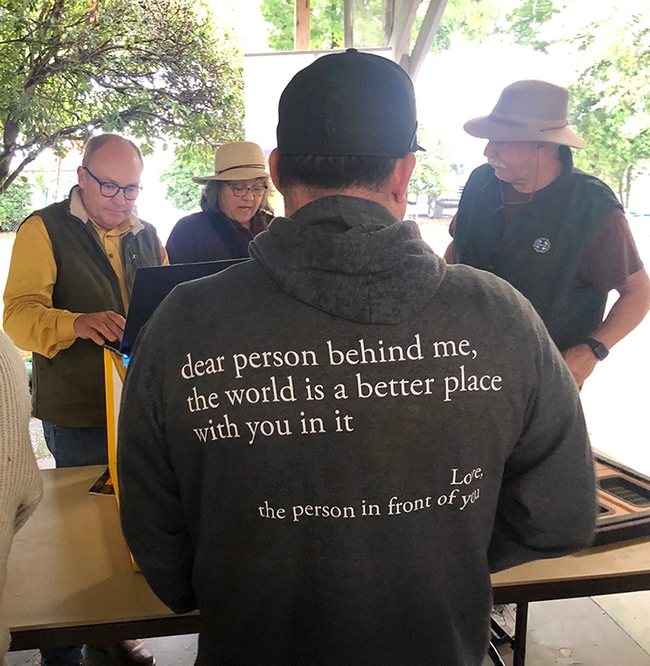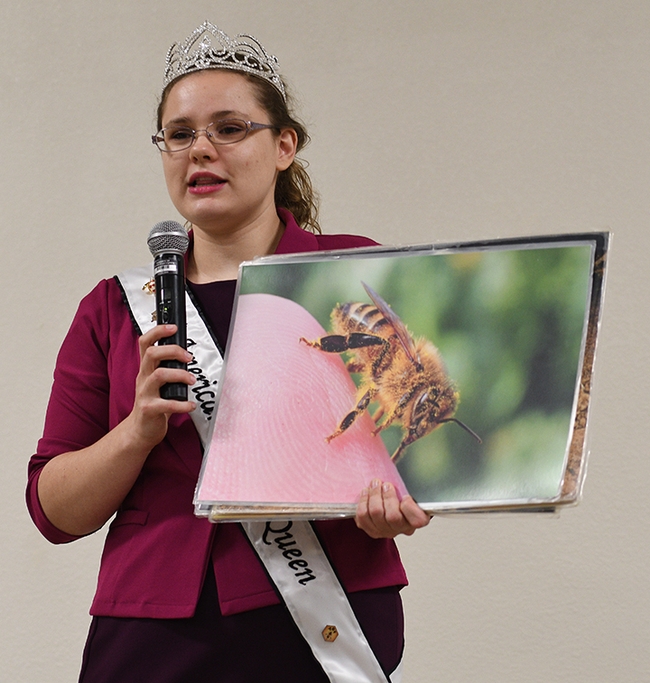- Author: Kathy Keatley Garvey
UC Davis distinguished professor emerita Lynn Kimsey, director of the Bohart Museum of Entomology for 34 years until her retirement on Feb. 1, 2024, is among the 17 emeriti featured in a newly released video tribute to emeriti, an annual public service project by UC Davis distinguished professor Walter Leal.
The 17 featured represent about 20 percent of UC Davis faculty who retired in 2023-24.
Kimsey is a recognized authority on insect biodiversity, systematics and biogeography of parasitic wasps, urban entomology, civil forensic entomology, and arthropod-related industrial hygiene. A UC Davis entomology alumna, she received her undergraduate degree in 1975 and her doctorate in 1979.
Kimsey joined the entomology faculty in 1989 and became the Bohart Museum director in 1990. Although officially retired, she continues her research and as executive director of the Bohart Museum Society. She writes and publishes the quarterly newsletter.
In the video, Leal notes that Kimsey "is an entomologist interested in the systematics of stinging wasps, insect biotic diversity, and urban entomology...she provided insect diagnostics for the public and corporations, non-profit organizations, and governmental agencies."
"Her research focused primarily on cuckoo wasps, hornets, and tiphiid wasps, describing more than 30 new genera and 300 new species of wasps. Her fieldwork included biotic surveys of the insect fauna of various desert sand dune systems in California and tropical habitats in Central America and Southeast Asia."
Kimsey served as president of the International Society of Hymenopterists from 2002-2004, and as a member of the board of directors of the Natural Science Collections Alliance in 2000 and 2001. The Pacific Branch, Entomological Society of America (PBESA) singled her out for its highest honor, the C. W. Woodworth Award, in 2020. She received the PBESA Systematics, Evolution, and Biodiversity Award in 2014 and was a member of "The Bee Team" that won the PBESA Outstanding Team Award in 2013. The UC Davis Academic Senate honored her with its Distinguished Scholarly Public Service Award in 2016 in recognition of her outstanding work. And in 2023, CA&ES selected her as the recipient of its Exceptional Faculty Award. She was honored with a 21-insect net salute in April.
In addition to the faculty highlights, Leal included brief messages by Chancellor Gary May, Provost Mary Croughan, and Suad Joseph, the UC Davis Emeriti Association (UCDEA) president. UCDEA interviews and records emeriti who have made "significant contributions to the development of the university." See Video Records Project.
"I know our emeriti are feeling the energy at UC Davis as we prepare to greet our incoming class of students," said Chancellor May in the video transcript. "I want to extend a welcome to all our emeriti professors and encourage you to remain involved in our vibrant campus activity just as you've been such an important part of our success."
Those featured on the video tribute, in order of appearance:
- Stuart Meyers, professor emeritus, Department of Anatomy, Physiology, and Cell Biology, School of Veterinary Medicine
- Peter Mundy, emeritus distinguished professor, Department of Education, and the Department of Psychiatry, College of Letters and Science
- Vaidehi Ramanathan, professor emerita, Department of Linguistics, College of Letters and Science
- Scott Simon, distinguished professor emeritus, Department of Biomedical Engineering, College of Engineering
- Bruce German, distinguished professor emeritus, Department of Food Science and Technology, College of Agricultural and Environmental Sciences
- Lynn Kimsey, distinguished professor emerita, Department of Entomology and Nematology, College of Agricultural and Environmental Sciences
- Leonard Abbeduto, professor emeritus, Department of Psychiatry and Behavioral Sciences, School of Medicine
- Lynette Hart, professor emerita, Department of Population Health and Reproduction, School of Veterinary Medicine
- Frank Sharp, distinguished professor emeritus, Department of Neurology, School of Medicine
- Stephen Wheeler, professor emeritus, Urban Design and Sustainability, Department of Human Ecology, College of Agricultural and Environmental Sciences
- Esther Kim, professor emerita, Eye Center, School of Medicine
- Julia Menard-Warwick, professor emerita, Department of Linguistics, College of Letters and Science
- Mohamed Hafez, professor emeritus, Department of Mechanical and Aerospace Engineering, College of Engineering
- Geoffrey Schladow, professor emeritus, Department of Civil and Environmental Engineering, College of Engineering
- Gail Taylor, distinguished professor emerita, Department of Plant Sciences, College of Agricultural and Environmental Sciences
- Paul FitzGerald, distinguished professor emeritus, Department of Cell Biology and Human Anatomy and Department of Ophthalmology and Vision Science, School of Medicine
- Alan Balch, distinguished professor emeritus, Department of Chemistry, College of Letters and Science
Additionally, Leal spotlighted (1) an emeriti “caught on camera” (Geerat J. Vermeij) heading to work two years after his retirement ("to stress how many members of the Emeriti remain engaged in UC Davis affairs"), and (2) UC Davis faculty member (Alan Balch) who broke the record on the number of years of service to the University of California (56 years, which included 52 at UC Davis).
Leal creates an annual tribute to UC Davis emeriti as a public service to celebrate their accomplishments as they enter a new chapter in their lives. It is a zero-budget, one-person production.
Leal launched his first "Tribute to Our New Emeriti," featuring 24 professors from eight colleges and schools who transitioned to emeriti in 2021-2022. (See news story.) The 2022-23 tribute is here. (See news story)
Leal, a member of the Department of Molecular and Cellular Biology faculty since 2013, is a former professor and chair of the Department of Entomology. He is the first UC Davis faculty member to win all three of the Academic Senate's most coveted awards: in research, teaching, and public service. Leal received the 2020 Distinguished Teaching Award for Undergraduate Teaching; the 2022 Distinguished Scholarly Public Service Award; and the 2024 Distinguished Faculty Research Award.
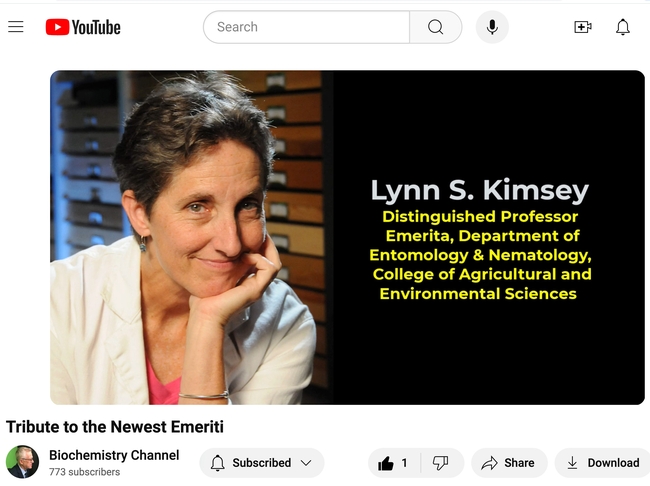
- Author: Kathy Keatley Garvey
It's the Fourth of July and what better time to post images of the aptly name "soldier beetles" than today.
These insects (family Cantharidae) resemble the uniforms of the British soldiers of the American Revolution, which is apparently how their name originated. They're also called "leatherwings" in reference to their soft, leatherylike wing covers.
Like lady beetles, aka ladybugs, these soldier beetles make short work of aphids and other soft-bodied insects. We've seen them devour so many aphids on our plants that they should be awarded the Aphid Belt, similar to Joey Chestnut's famed Mustard Belt.
Indeed, soldier beetles are eating machines, just like Joey.
Wikipedia describes Joey Chestnut (who, by the way, grew up in Vallejo, Solano County), as an "American competitive eater" ranked No. 1 in the world by Major League Eating. In addition to hot dog-eating contests, Chestnut has won contests devouring pizza, wontons, chicken wings, and corned beef sandwiches. And even poutine (french fries and cheese curds, topped with brown gravy).
No aphids, yet, though. Not even sprinkled on pizza slices.
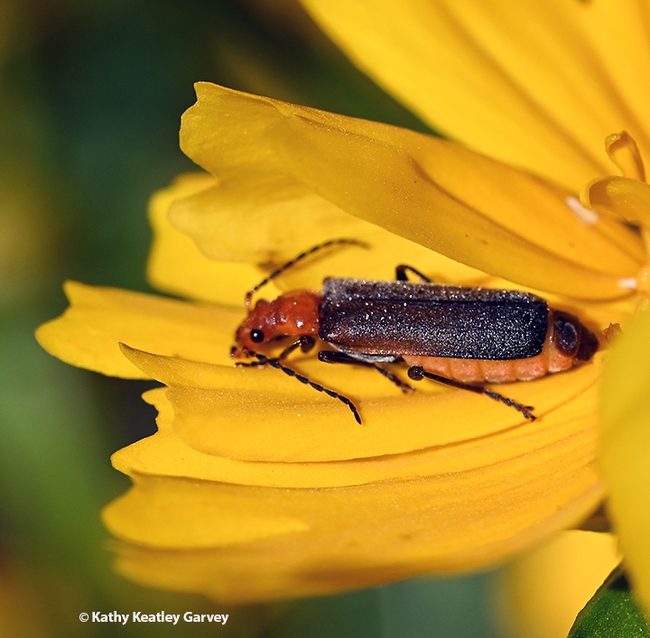
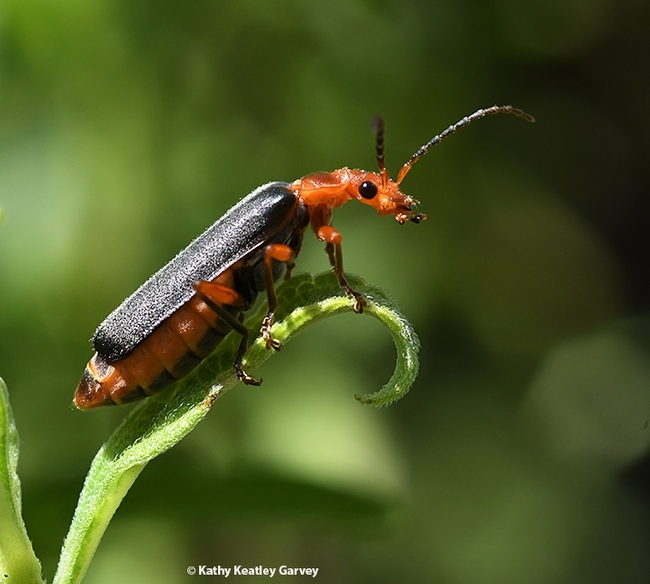
- Author: Kathy Keatley Garvey
If you missed UC Davis distinguished professor James R. Carey's well-attended seminar on "California's Fruit Fly Invasion: A 70-Year Struggle Nears Critical Mass," it's now online on YouTube.
His seminar, which took place June 3 in Briggs Hall, UC Davis, and on Zoom, drew global interest, stretching as far as Australia.
Carey pointed out that Callfornia has "the largest agricultural industry in the United States ($55 billion), is the fifth largest worldwide supplier of agricultural produces, grows more than 200 different crops, and "most fruit crops have been attacked by multiple tephritid species."
The California Department of Food and Agriculture (CDFA) reported that the first Mediterranean fruit fly (medfly) outbreak occurred on June 5, 1980, he said, and as of June 3, the state has detected 18 total species of fruit flies in 350 cities, amounting to 11,000 detections.
In his hour-long seminar, Carey presented an overview of the long-developing crisis, discussed lessons learned from analysis of fruit fly detection databases, and argued that "in order to have any chance at stemming this ever-rising tide, CDFA and the USDA urgently need to switch from their historic, ad hoc eradication strategy to a new one that is evidence-based and far more scientific."
In the closing moments, he asked "Why have oriental fruit fly outbreaks been occurring annually for the past 60 years in California?"
Because, he said, the fruit flies are "permanently established."
Carey, a 44-year member of the UC Davis faculty who is retiring in June, and a senior scholar in the Center for the Economics and Demography of Aging at UC Berkeley, researches insect biodemography, mortality dynamics, and insect invasion biology. He holds a doctorate in entomology from UC Berkeley (1980).
Carey served on the CDFA's Medfly Scientific Advisory Panel from 1987-1994, testified to the California Legislature "Committee of the Whole" in 1990 on the Medfly Crisis in California, and authored the paper "Establishment of the Mediterranean Fruit Fly in California" (1991, Science 258, 457).
He is a fellow of four professional societies: Entomological Society of America, the American Association for the Advancement of Science, the California Academy of Sciences, and the Gerontological Society of America. He is former director (2003-13) of a 11-university consortium funded by the National Institute on Aging (NIH/P01) on the evolutionary ecology of lifespan. He co-authored the book “Biodemography: An Introduction to Concepts and Methods” (Carey, J. R. and D. Roach. 2020; Princeton University Press) and authored the books, “Demography for Biologists (Oxford University Press 1993), Longevity (Princeton University Press, 2003), and Longevity Records: Life Spans of Mammals, Birds, Amphibians and Reptiles (Odense, 2000) as well as more than 250 journal articles and book chapters.
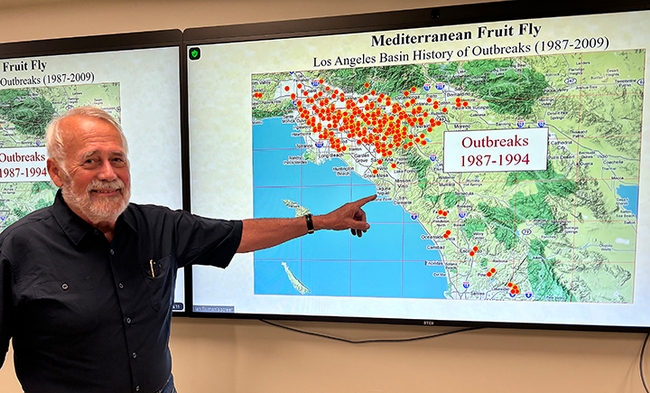
- Author: Kathy Keatley Garvey

Ricardo Vela, manager of UC ANR News and Information Outreach in Spanish (NOS), won the ACE 2024 Rising Star Award, an annual award that "honors communicators, instructors and researchers who demonstrate exceptional leadership and technical skills in their communication field, to their institution, and service to ACE."
Five other UC ANR communicators won either a gold (first place), silver (second place), or a bronze (third place) award.
- A trio from UC ANR Strategic Communications--Michael Hsu, senior public information representative; Ethan Ireland, senior videographer; and Evett Kilmartin, photographer--teamed to win a silver award for their video, “Farm-to-Corrections Project."
- Strategic Communications' social media strategist Doralicia Garay won a bronze award for her entry, “Improving Lives in California” in the category, social media organic campaign.
- Kathy Keatley Garvey, communications specialist for the UC Davis Department of Entomology and Nematology and author of the Bug Squad blog on the UC ANR site, won a gold award for “best feature photo."
They will receive their awards at the ACE conference, scheduled June 23-25 in Salt Lake City Utah. The theme: “Big Ideas Start Here.”
Ricardo Vela
Ricardo Vela is a 35-year, two-time Emmy-winning broadcast journalism professional, as noted on the ACE site. As program manager of NOS, he supervises a Spanish-language expert team that disseminates news and research about agriculture, nutrition, and natural resources to Spanish-speaking communities across California. Vela is “an advocate for Latino and other ethnic groups, promoting their contributions to society and creating for the first time, events for the UC ANR community to celebrate Hispanic Heritage Month and Cesar Chavez Day.”
Before joining UC ANR, Vela worked as a national news correspondent for Univision and CNN in Texas and Los Angeles. He started his journalism career at the Chicago Tribune and Univision in Chicago, Ill. While in Chicago, he collaborated with several Latino community organizations, always promoting equity and inclusion. He served as Univision's main news anchor in San Diego for 17 years and hosted a morning talk radio show,“Voces Hispanas,” for 10 years. His career includes serving as news director and anchor at Entravisión (a Univisión affiliate) in Palm Springs and as a news anchor at Telemundo in El Paso, Texas. In 2006, Hispanic Magazine listed him as among the 100 most influential Latinos in the country.
UC ANR Vice President Glenda Humiston appointed Vela as a founding member of the UC Diversity, Equity, and Inclusion Committee to serve a three-year term.
The ACE Rising Star Award memorializes Frank Jeter (1891-1955), a pioneering ACE member from North Carolina who made significant contributions to the communication field and to ACE.
Michael Hsu, Ethan Ireland and Evett Kilmartin
The Hsu-Ireland-Kilmartin team produced a video featuring UC ANR's Nutrition Policy Institute (NPI) and its unique partnership with Impact Justice, ChangeLab Solutions, Spork, and the California Department of Corrections and Rehabilitation (CDRC). Last July they launched the "Farm-to-Corrections Harvest of the Month" project, which brings fresh, specialty produce into California prisons “to improve the diets of the residents, as well as improve their overall health and well-being.” Impact Justice is a prison reform organization, ChangeLab Solutions is a health equity nonprofit, and Spork is a regional food hub.
The video, Hsu said, aims to raise awareness and build support for the project. He cited its many wins:
- Opens major untapped market for California growers and producers (especially small farmers)
- Demonstrates a way for CDCR to meet requirements for in-state sourcing of food
- Provides healthier food for residents of the correctional facilities, while introducing new produce and nutrition education opportunities that can help them live better lives while they are in prison and after they return to their communities.
Hsu conducted the interviews and wrote the script; Ireland shot and edited the video; and Kilmartin contributed photos. Some images were taken in the California Department of Corrections, California State Prison, Solano (Vacaville). (See the news story, "Farm-to-Corrections' Project Provides Fresh Produce to People in Prison, Boosts California Growers.")
Doralicia Garay

"The campaign's strategic emphasis on showcasing employees within the narrative of research efforts enhances the UC ANR brand identity and positions the organization as a collaborative pioneer in innovation," Garay wrote. "This comprehensive approach leverages the power of social media to extend reach, foster engagement, and effectively cater to our online community."
Among those featured in "Improving Lives in California:" entomologist Ian Grettenberger, assistant professor of Cooperative Extension, and a member of the faculty of the UC Davis Department of Entomology and Nematology.
Kathy Keatley Garvey
Kathy Keatley Garvey, a journalist formerly with UC ANR before joining the UC Davis Department of Entomology and Nematology, submitted an image of a honey bee buzzing over a zinnia. Her entry, “Celebrating the Honey Bee," won the feature photo category, for "one image that effectively tells a story."
"The purpose of this photo was to celebrate the honey bee by capturing an image of a pollen-packing worker bee in flight over a bright flower," wrote Garvey. Her gear: a Nikon D500 with a 105mm lens. Settings: 1/4000 of a second (to freeze the action), ISO 1000, and f-stop 6.3. She sought to showcase "the amazing color: the bright red zinnia and the orange pollen;" the bee's speed (deliberately blurring the wings); and "to emphasize that foraging honey bees are incredible workers."
"That is one huge ball of pollen that she'll take back to her colony," Garvey wrote. Feedspot, which ranks blogs by traffic, social media followers and freshness, ranks her Bug Squad blog as the No. 4 bug blog in the world, Garvey has written the blog every night, Monday through Friday, since Aug. 6, 2008.
Communication Professionals
ACE, headquartered in Morton Grove, Ill., describes it members as "communication faculty and professionals at public and land-grant universities throughout the United States and in similar institutions in other nations.We are communication professionals at local, state and federal agencies; corporations and nonprofit organizations; and agriculture- and natural resources-focused international research centers."
Its members include "writers, editors, graphic designers, webmasters, video producers, information technologists, photographers, administrators, researchers, faculty members and others in the communications field. We plan, prepare and disseminate research results and Extension educational materials. We distribute research-based information to scientists and technicians, and practical, problem-solving information to people who put it to work: farmers, families, foresters, food processors, ranchers, homemakers, news media, youth, marine businesses, businesses and many others."
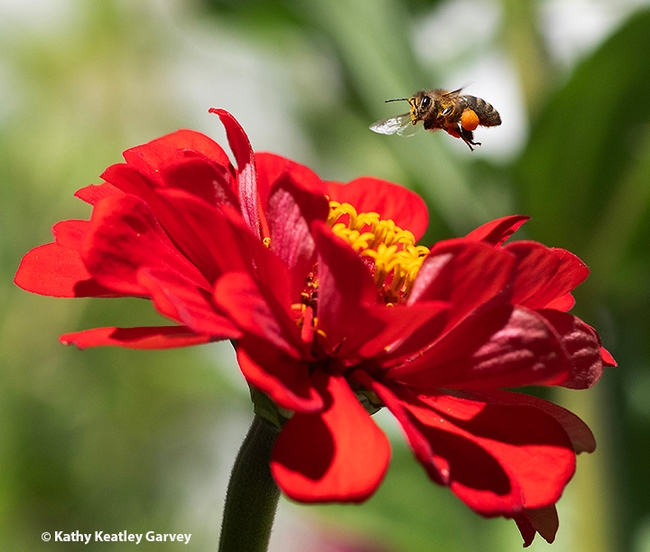

- Author: Kathy Keatley Garvey
It was all the buzz.
Thousands of bee and honey enthusiasts made a beeline for the California Honey Festival, held last Saturday on the Yolo County Fairgrounds.
The annual festival, relocated this year from the streets of downtown Woodland to the fairgrounds due to a weather forecast cautioning heavy rain and wind, drew scores of smiles beneath the arched umbrellas.
Beekeeper Rick Moehrke, a retired Vacaville teacher, answered questions about bees in the Sacramento Area Beekeepers' Association booth.
American Honey Queen Kaelyn Sumner of Cecil, Wisc., a beekeeper and a senior at Kansas State University discussed queen bees, worker bees and drones. She is majoring in agricultural education and minoring in food science and entomology.
Charles McMaster, a U.S. Army veteran from Copperas Cove, Texas, headed the Hives for Heroes booth. The national non-profit service organization focuses on sustainability, conservation, and providing a healthy transition from service: "Through our national network of beekeepers, we provide connection, purpose, and healthy relationships, through access, resources, and funding for Active Duty, Veterans, and First Responders.">
Steve Hays, retired sheriff's deputy, Sacramento County and founder of Second Chance Beekeeping Reentry Service, chronicled the history of his program and how inmates are learning beekeeping and getting "a second chance." (See news story)

Amina Harris, retired founding director of the UC Davis Honey and Pollination Center and now the "Queen Bee" of her family's Woodland-based Z Food Specialty and The HIVE, offered guests "a taste of honey" from all over California. They also sold honey, including a family favorite, starthistle. Harris co-founded the California Honey Festival in 2017 with the City of Woodland.
Attendees tasted and purchased Hawaiian honey, with such varietals as Eucalyptus, macadamia, mango, Christmas bush, tropical blossom and wildflower, from "Queen Bee" Inna Eyrih, business owner of Hawaiian Honey AT&S, a company based in Hawaii (Keaau) and California.
GATEways horticulturist Rachel Davis of the UC Davis Arboretum and Public Garden discussed pollinator gardening, focusing on native bees, butterflies, moths, hoverflies, and hummingbirds.
This year's California Honey Festival lived up to its mission: to emphasize the importance of bees and to promote honey and bee products. The annual festival, co-sponsored by UC Davis, features educational presentations, kids' center activities, honey tasting, cooking demonstrations, a beer and mead garden, live music, vendors and more.
